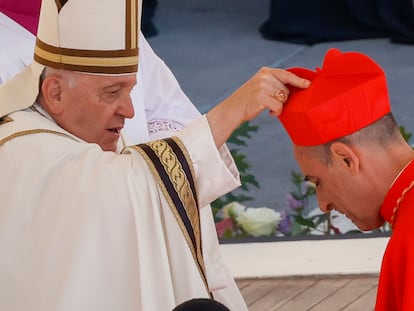Pope Francis’ reformist agenda leads Catholic Church to take an ‘extraordinary step forward’
European cardinals gain influence ahead of the synod that begins this Wednesday in an attempt to modernize the Church and tackle thorny issues such as same-sex couples and the role of women in the Church

After a series of unique circumstances, the Catholic Church has found itself at a turning point. One of them is the synod that begins this Wednesday, a kind of meeting of bishops that convenes with relative frequency to discuss issues that affect Catholicism. On this occasion, the meeting does not have a specific question on the table, unlike previous synods in which the debate focused on the family, young people, or the Amazon. The theory says that synodality itself will be debated, although in practice it will serve to try to modernize the Church and will address thorny and traditionally divisive issues for Christians, such as the role of women in the institution, the blessing of same-sex couples, euthanasia, contraceptives, communion of the divorced, and celibacy. The ambitious goal has been set of involving the entire Church, that is, all baptized Catholics.
In 2021, local churches officially began discussions. This month, the bishops and other ecclesiastical representatives will meet in Rome, and from then until October of next year, when they will meet again in the Italian capital, the discussions will continue in their respective countries.
In this context, a few days before the start of the meetings, Pope Francis on Saturday created a new batch of cardinals in a consistory that, by arithmetic, could be the last of the pontificate, and which is highly politically charged. In total, he named 21 prelates, of which 18, due to their age — under 80 years of age — will have the right to vote at the next conclave in the Sistine Chapel. “It is as if before going into battle, the Pope appointed his captains general. This consistory is strictly linked to the synod, it is something that has never happened before,” says Piero Schiavazzi, professor of Vatican Geopolitics at Link University in Rome and journalist who specializes in Vatican issues. It is the ninth consistory for Bergoglio, who has held one a year since he was elected pontiff, with the exception of 2021.
This batch of cardinals is unusual in many ways and breaks the tendency of previous consistories to move towards the peripheries, especially towards Asia and Africa. Pope Francis, who has traditionally criticized the Church for being “too European,” is now targeting Europe as never before and preparing for what is to come. Half of those newly appointed — crucially, with the right to vote — are Europeans and another four are Americans. That means that 13 out of 18 come from the Western Hemisphere. “We must be clear that the modernization of the Church on the great anthropological questions comes through Europe. In the West, there is greater sensitivity towards certain issues such as gender or homosexuality than in Asia or Africa. Although in Europe and the United States the Church is in decline, paradoxically the young Churches that are growing in Asia or Africa are the most conservative. Western societies are moving towards a new idea of mankind, and that game is undoubtedly being played in Europe, which is why there are so many European cardinals in this consistory,” says Schiavazzi.
Spanish cardinals
Pope Francis has given the privilege of the cardinal’s scarlet to men very close to him, who share his same ideological line, and who are generally reformers, albeit moderates. Among the Spaniards, José Cobo Cano stands out, recently appointed archbishop of Madrid, he is representative of a new generation of bishops in Spain, with a more pastoral than institutional profile, extensive parish experience, social commitment, and a great defender of migrants.
Another is Ángel Fernández Artime, rector major of the Salesians, who is very close to Bergoglio. It is not common for a superior of a religious congregation who is not even a bishop to become a cardinal, but Fernández knows the Pope very well and shares his ideology. Their friendship and collaboration dates back to when Francis was still archbishop of Buenos Aires.
Faithful men
The other Spaniard, a bishop in Corsica, is François-Xavier Bustillo. A Franciscan, he also met Bergoglio in Buenos Aires and has a very pastoral profile. “To manage these years of synod, the Pope wanted to surround himself with his faithful men. To change the political line of the Church, a Pope needs a ruling class who share his ideas,” Schiavazzi assesses.
This concept can be seen very well in the figure of the American Robert Francis Prevost, the first of the new cardinals, who was not promoted by chance. He is a very powerful presence in the Holy See and is responsible for appointing the ruling class of the Church. Moreover, Prevost is considered a progressive who is a strong defender of missions, having been a missionary in Peru for many years.
He replaces the more conservative Marc Ouellet in the dicastery, who was named cardinal by John Paul II and prefect of Bishops by Benedict XVI. “A Pope cannot modernize the Church alone, to do so he has to change the ruling class, and that will take at least 10 years. When a pontiff is elected, he must govern the Church at the beginning with the bishops chosen by the predecessor, until they reach the age of 75 when they can retire. Now Francis has placed a missionary at the head of his ministry to the Bishops. It is like recognizing that all countries are mission territories, where there is nothing to defend but still much to conquer. In many countries, especially in Europe, there are a majority of baptized people, but the churches are empty. Francis wants to woo the faithful with a progressive policy, instead of a conservative one,” says Schiavazzi.
The same idea is reflected by another of the new cardinals, the Argentine Víctor Manuel Fernández, prefect for a few weeks now of another key organization, the Dicastery for the Doctrine of the Faith, the ancient Inquisition, and who is a man of dialogue more than a guardian of old-fashioned dogma. Pope Francis himself revealed that he expected something very different from what he had seen so far.
Avoid schism
Pope Francis needs authoritative voices to approve his reforms and guarantee that the changes he has introduced are maintained, but he must do so with moderation to avoid a schism in the Catholic Church. Currently, there are two opposing currents in the Church, which will come face to face at the synod: the conservative voices are represented by the United States, while the more progressive ones are championed by the German bishops. The latter are forging their own synodal path to seek reforms (which has been censured by the Vatican). In it, they have put on the table issues such as the ordination of women, same-sex unions, and marriage for priests.
“The great problem of the Synod is to keep the Church united and avoid the risk of schism. One cannot expect a forceful response for same-sex couples or the prominence of women in the Church; the Pope is trying to find a formula that will allow him to establish a moderate reform. All the new cardinals respond to a profile of prudent reformism. In political terms it can be said that a center-left Church has emerged from this consistory. Francis knows that he is playing a very important game; it must offer a progressive line, but it cannot go too far and run aground,” Schiavazzi comments.
A new progressive Pope
We must also view this council with an eye on a future conclave. For a matter of arithmetic, it is likely that this will be Francis’s last and that the current college of cardinals, the body that makes up the high Catholic hierarchy, will be the one that elects the next Pope. Nothing is set in stone, but for some time now the maximum number of electors has been around 120. Currently, there are 137 cardinals with the right to vote, of which 99 have been appointed by Francis, 29 by Benedict XVI and 9 by John Paul. II. Although heaven is not governed by earthly rules and conclaves are not an exact science, if the college of cardinals were a chamber, Francis would have an overwhelming absolute majority. “He has his men in all important places in the Roman curia, the college of cardinals completely bears his personal imprint, he has the government of the Church in his hands, he has made sure to begin a process that he will not see complete, but that It is irreversible… It is feasible that the new Pope will also be progressive, along the lines of Francis,” says Schiavazzi.
Francis is the architect of the largest geographic distribution of power in the history of the Catholic Church. The trend of expansion towards the peripheries has been maintained in this council, although to a lesser extent compared to the past. The weight of Africa (14% of voters) and Asia (17.5% of voters), with hitherto minority nations or those that are geographically close to China, such as Mongolia, Laos, and Myanmar, continues to be strong in the college of cardinals and unprecedented in the history of the institution.
Experts, such as Roberto Morozzo Della Rocca, professor of Contemporary History at Roma Tre University and author of several books on religion, consider that the college of cardinals appointed by Francis reflects the university of the Church and represents “all angles of Christianity.” But at the same time, their disparate origins raise the question of how to approach the election of the new Pope. “Beyond their functions as advisors, among the cardinals there is no homogeneity of cultures or social vision. They are very different among themselves. What they have in common is that they are all cardinals of the Catholic Church. It is difficult to imagine how they will orient themselves when there is a conclave, since there are no apparent pre-constituted majorities,” says Morozzo Della Rocca.
Sign up for our weekly newsletter to get more English-language news coverage from EL PAÍS USA Edition
Tu suscripción se está usando en otro dispositivo
¿Quieres añadir otro usuario a tu suscripción?
Si continúas leyendo en este dispositivo, no se podrá leer en el otro.
FlechaTu suscripción se está usando en otro dispositivo y solo puedes acceder a EL PAÍS desde un dispositivo a la vez.
Si quieres compartir tu cuenta, cambia tu suscripción a la modalidad Premium, así podrás añadir otro usuario. Cada uno accederá con su propia cuenta de email, lo que os permitirá personalizar vuestra experiencia en EL PAÍS.
¿Tienes una suscripción de empresa? Accede aquí para contratar más cuentas.
En el caso de no saber quién está usando tu cuenta, te recomendamos cambiar tu contraseña aquí.
Si decides continuar compartiendo tu cuenta, este mensaje se mostrará en tu dispositivo y en el de la otra persona que está usando tu cuenta de forma indefinida, afectando a tu experiencia de lectura. Puedes consultar aquí los términos y condiciones de la suscripción digital.
More information
Archived In
Últimas noticias
Most viewed
- Alain Aspect, Nobel laureate in physics: ‘Einstein was so smart that he would have had to recognize quantum entanglement’
- David King, chemist: ‘There are scientists studying how to cool the planet; nobody should stop these experiments from happening’
- Maps of the US attack on Venezuela: Targets, airspace and deployed fleet
- Key points of the military attack on Venezuela: Early morning bombings and a ‘captured’ president
- Mexico completes its trade shift with the entry into force of tariffs on China and countries without trade agreements










































